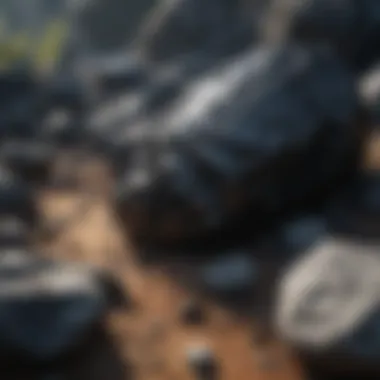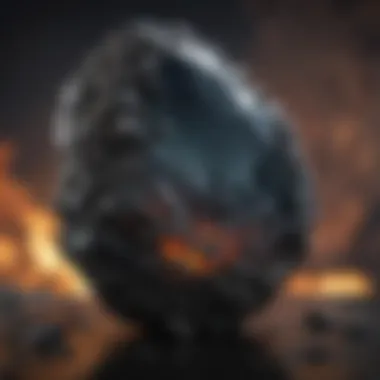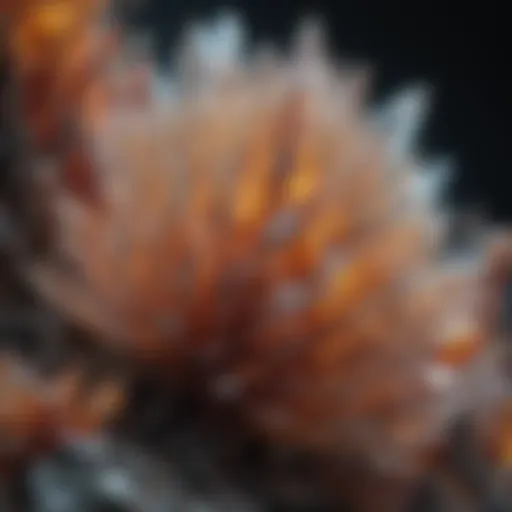Unveiling the Ultimate Guide to Acquiring Obsidian Rocks


Rock and Fossil Identification
Obsidian, a captivating natural glass formed from volcanic processes, boasts unique characteristics that distinguish it from other rocks and minerals. Unlike traditional minerals, obsidian lacks a crystalline structure due to its rapid cooling from molten lava. When examining obsidian, collectors should pay attention to its glossy and smooth texture, as well as its sharp edges formed from rapid cooling. Furthermore, the color of obsidian varies depending on impurities present during its formation.
Types of Obsidian
Obsidian showcases a diverse range of types, each with distinct properties and appearances. Some common types include Snowflake Obsidian, Mahogany Obsidian, and Rainbow Obsidian. Snowflake Obsidian features white splotches dispersed across a black base, resembling snowflakes, whereas Mahogany Obsidian displays reddish-brown swirls within its black structure. Rainbow Obsidian exhibits bands of colorful sheen caused by light reflection on microscopic inclusions.
Characteristics to Note
When assessing obsidian specimens, collectors should note its conchoidal fractures, resulting in curved and sharp edges akin to broken glass. These fractures contribute to its historical use in crafting tools and weapons. Additionally, obsidian's lack of cleavage distinguishes it from minerals like quartz, aiding in its identification.
Tools for Identification
Inspecting obsidian often requires tools such as a hand lens for magnification to observe its unique features closely. Mohs hardness picks can assist in determining its hardness, usually around 5.5 on the Mohs scale. Furthermore, a black light can reveal fluorescent qualities in certain obsidian types, aiding in their identification.
Introduction
Obsidian, a captivating volcanic glass with a rich history and unique properties, has intrigued collectors and enthusiasts for centuries. In this comprehensive guide to buying obsidian rock, we delve into the intricacies of this mesmerizing material, providing valuable insights for both seasoned collectors and newcomers to the world of rocks and minerals.
Understanding Obsidian
What is Obsidian?
Obsidian, born from the fierce fires of volcanic eruptions, is a natural glass renowned for its exceptional beauty and sharpness. Its allure lies in its smooth texture, intense black color, and ability to hold a razor-sharp edge. This volcanic glass is a favorite among collectors for its unique origin and striking appearance. Although its lack of crystalline structure may be viewed as a downside by some mineral enthusiasts, its aesthetic appeal and historical significance make it a compelling choice for any rock collection.
Formation Process of Obsidian
The formation process of obsidian is as fascinating as the stone itself. When felsic lava rapidly cools upon exposure to air or water, obsidian is born without crystallization, resulting in its distinctive glassy texture. This rapid cooling inhibits the growth of mineral crystals, giving obsidian its smooth, reflective surface. While some may argue that its lack of crystalline structure reduces its value as a collector's item, others appreciate obsidian for its unique formation process and resulting beauty.
Properties of Obsidian


Obsidian boasts a unique set of properties that set it apart from other rocks and minerals. With a vitreous luster and conchoidal fracture, obsidian exhibits sharp edges when fractured, making it an ideal material for tools and ornamental pieces. Its high silica content contributes to its durability and resistance to weathering, ensuring that obsidian remains pristine over time. Despite its lack of internal crystal structures, obsidian's sheer elegance and potential for diverse applications make it a prized possession among collectors.
Significance of Obsidian in Geology
Geological Importance of Obsidian
In the realm of geology, obsidian holds significant value due to its volcanic origin and rapid formation process. Geologists study obsidian to gain insights into past volcanic activities, evaluating its chemical composition and physical characteristics. The presence of obsidian in specific geological formations can indicate the occurrence of ancient volcanic events or provide clues about the Earth's history. While some may overlook obsidian's geological significance, its role in deciphering geological timelines and volcanic processes cannot be underestimated.
Common Locations for Obsidian
Obsidian can be found in various regions across the globe, with notable deposits present in volcanic areas such as the western United States, Japan, Mexico, and parts of Europe. These volcanic locations offer rich sources of obsidian, each with unique chemical compositions and colors. Collectors often scour these regions in search of rare obsidian varieties, adding geographic diversity and historical significance to their collections.
Why Buy Obsidian?
Decorative Purposes
The aesthetic appeal of obsidian makes it a popular choice for decorative purposes. Its deep black color and glassy sheen lend an air of sophistication to any setting, whether displayed as a standalone piece or incorporated into jewelry and home decor. The contrast between obsidian and other gemstones adds depth and intrigue to decorative creations, making obsidian a preferred choice for those seeking to enhance their surroundings with elegance and allure.
Metaphysical and Spiritual Beliefs
Beyond its physical properties, obsidian holds symbolic significance in various cultures and belief systems. Many view obsidian as a protective stone, capable of deflecting negative energy and promoting emotional clarity. In spiritual practices, obsidian is associated with grounding and protection, offering strength and balance to those who possess it. Whether used for meditation, healing rituals, or personal empowerment, obsidian's metaphysical attributes attract individuals seeking a deeper connection to the Earth and themselves.
Factors to Consider Before Buying
When delving into the world of purchasing obsidian rock, it is crucial to understand the significant factors to consider before making a well-informed decision. Authenticity and certification play pivotal roles in ensuring that you acquire a genuine and high-quality obsidian specimen. By examining the authenticity and certification of the obsidian, buyers can safeguard themselves against fraudulent or subpar products. Additionally, exploring the various varieties of obsidian, ranging from common types to those with unique characteristics, allows collectors to pinpoint their preferences and find specimens that resonate with their individual tastes and interests. Quality and clarity are paramount when selecting obsidian, as they impact the visual appeal and value of the rock, making it essential for buyers to assess the physical quality and evaluate the clarity and color of the obsidian they intend to purchase.
Authenticity and Certification
Ensuring Genuine Obsidian
When it comes to ensuring the authenticity of obsidian, buyers must pay close attention to specific features that distinguish real obsidian from imitations or lesser-quality alternatives. Characteristics such as a glass-like luster, conchoidal fractures, and absence of crystalline structures are key indicators of genuine obsidian. By verifying these attributes, buyers can confidently identify authentic obsidian and avoid misrepresentation in the market. Genuineness in obsidian guarantees that collectors acquire a rock formed through natural volcanic processes, preserving its geological and aesthetic value.
Certification Standards


Certification standards serve as benchmarks for validating the authenticity and quality of obsidian specimens. Obtaining certification from reputable gemological institutions provides buyers with documented assurance regarding the origin, composition, and characteristics of the obsidian they are purchasing. These standards not only certify the genuineness of the rock but also offer insights into its geological significance and unique properties. By adhering to established certification standards, collectors can build trust in their acquisitions and expand their knowledge of obsidian variations and attributes.
Varieties of Obsidian
Common Types of Obsidian
Exploring the common types of obsidian, such as Snowflake Obsidian and Rainbow Obsidian, offers collectors a glimpse into the diverse world of this volcanic glass. Each type exhibits distinct patterns, textures, and colors, catering to varied aesthetic preferences and collection themes. While Snowflake Obsidian features white 'snowflake' patterns against a dark background, Rainbow Obsidian showcases iridescent bands of color, creating visually striking specimens that stand out in any collection.
Unique Characteristics
Unique characteristics in obsidian, such as sheen obsidian and mahogany obsidian, add an element of rarity and allure to the collector's repertoire. Sheen obsidian displays a reflective surface resembling polished metal, providing a captivating play of light and shadow. On the other hand, mahogany obsidian exhibits rich brown hues interwoven with black streaks, resembling the depth and warmth of mahogany wood. These unique variations in obsidian appeal to collectors seeking distinctive and visually captivating specimens for their collections.
Quality and Clarity
Assessing Physical Quality
Assessing the physical quality of obsidian involves examining its texture, hardness, and overall craftsmanship to ensure that the rock meets established standards of excellence. High-quality obsidian should display a smooth texture free from blemishes or imperfections, with a hardness comparable to glass that enables precision shaping and carving. By scrutinizing the physical attributes of obsidian, collectors can discern superior specimens that reflect the natural beauty and durability of this volcanic glass.
Evaluating Clarity and Color
Evaluating the clarity and color of obsidian is essential for determining its visual appeal and desirability in collections. Clarity refers to the transparency and lack of inclusions within the obsidian, with clearer varieties commanding higher value and interest among enthusiasts. The color of obsidian ranges from classic black to smoky gray, with rare hues like green and red attracting discerning collectors seeking unique and unconventional additions to their assemblage. By evaluating clarity and color, buyers can curate a diverse and visually stunning selection of obsidian specimens that showcase the rock's natural beauty and geological distinctiveness.
Where to Buy Obsidian
In the fascinating world of obsidian, knowing where to buy this unique rock is crucial for enthusiasts seeking authentic specimens. Navigating the avenues for acquiring obsidian adds a layer of excitement to the buying journey. Whether you prefer the tactile experience of physical stores or the convenience of online shopping, the options available cater to diverse preferences and requirements.
Physical Rock and Gem Stores
Benefits of In-Person Shopping
Embarking on a journey to procure obsidian from physical rock and gem stores provides an immersive experience unlike any other. The tangible aspect of selecting obsidian in person allows buyers to interact with the specimens, feeling the texture and observing the nuances up close. The sensory engagement enhances the connection to the rock, enabling a more personalized selection process. Additionally, physical stores often offer expert guidance from knowledgeable staff, fostering a learning environment for novices and collectors alike.
Tips for Selecting Stores


When scouting for the perfect rock and gem store to purchase obsidian, several considerations come into play. Choose reputable stores known for their authenticity and quality offerings. Look for a diverse selection of obsidian types to expand your collection. Consider the store's location and accessibility, ensuring a convenient shopping experience. Pay attention to customer reviews and feedback to gauge the store's credibility and customer satisfaction levels.
Online Retailers and Auction Sites
Venturing into the realm of online retailers and auction sites unveils a world of possibilities for procuring obsidian. The convenience of browsing through virtual catalogs and engaging in online auctions appeals to buyers looking for a seamless shopping experience. While online purchases offer a wide array of options at the click of a button, due diligence is essential to ensure the authenticity of the obsidian being procured.
Pros and Cons of Online Purchases
The allure of online purchases lies in the accessibility and variety of obsidian available across different platforms. Online retailers and auction sites offer a convenient avenue for buyers worldwide to acquire obsidian without geographical constraints. However, virtual transactions lack the tangible element present in physical stores, making it challenging to fully assess the quality and characteristics of the obsidian before purchasing.
Recommended Websites for Authentic Obsidian
In the vast digital landscape, discerning buyers can benefit from recommended websites that specialize in authentic obsidian. Trustworthy online platforms curated for rock and fossil enthusiasts provide a safe space to explore and purchase obsidian with confidence. These recommended websites often feature detailed descriptions, high-resolution images, and certification processes to guarantee the authenticity of the offered specimens, ensuring a fulfilling buying experience.
Tips for a Successful Purchase
Understanding how to make a successful purchase when buying obsidian rock is crucial for both novice enthusiasts and experienced collectors. In this section, we will delve into key factors that can impact your buying decision and provide valuable insights to enhance your overall shopping experience.
When it comes to purchasing obsidian, one of the fundamental aspects to consider is budgeting and pricing. Determining your budget is essential as it sets the financial parameters within which you can explore different options. By establishing a clear budget, you can narrow down your choices and focus on specimens that align with your financial capabilities and preferences.
Additionally, understanding price discrepancies in the obsidian market is vital for making informed purchasing decisions. Variations in pricing may reflect differences in quality, rarity, or the specific type of obsidian. By having a deeper understanding of price fluctuations, you can avoid overpaying for a specimen or missing out on a valuable find.
Effective negotiation and communication skills play a significant role in the purchasing process. When engaging with sellers, being able to communicate your requirements clearly and negotiating terms effectively can help you secure the best deal possible. By honing these skills, you can navigate transactions with confidence and ensure a mutually beneficial outcome for both parties.
Furthermore, proper care and preservation of your obsidian specimens are essential for maintaining their beauty and integrity over time. Implementing storage and display tips that protect the rock from potential damage or degradation is key to preserving its value and aesthetic appeal. Regular cleaning and maintenance routines can also prolong the lifespan of your obsidian collection, allowing you to enjoy its unique qualities for years to come.
Conclusion
In the intricate world of purchasing obsidian rock, the conclusion serves as the vital culmination of our comprehensive guide. It encapsulates the essence of the entire buying process, emphasizing the significance of informed decision-making and mindful selection. The conclusion consolidates all aspects discussed throughout the guide, offering readers a final perspective on how to navigate this fascinating realm. It acts as a compass, guiding enthusiasts towards making well-thought-out choices that align with their preferences and aspirations, ensuring a fulfilling obsidian buying journey.
Final Thoughts
Reflecting on Your Purchase
Reflecting on Your purchase is a pivotal step in the obsidian buying process as it allows enthusiasts to introspect and evaluate their acquisition. This moment of contemplation provides a deeper understanding of why a particular piece of obsidian caught their eye, unraveling the personal connection and allure behind the rock. By reflecting on the purchase, buyers can discern their inclinations and preferences, paving the way for more informed decisions in the future. This practice not only enhances the buying experience but also cultivates a profound appreciation for the beauty and diversity of obsidian.
Continuing Your Obsidian Journey
Continuing Your obsidian journey signifies the evolving relationship individuals develop with these captivating rocks beyond the point of purchase. It embodies a continuous exploration and discovery of the various facets of obsidian, from its geological origins to its metaphysical implications. By delving deeper into the world of obsidian, enthusiasts can expand their knowledge, broaden their collection, and deepen their connection with these mesmerizing specimens. Continuing the obsidian journey offers a dynamic and enriching experience, fostering a sense of curiosity and fascination that transcends the act of buying, making it a compelling journey of exploration and learning.







